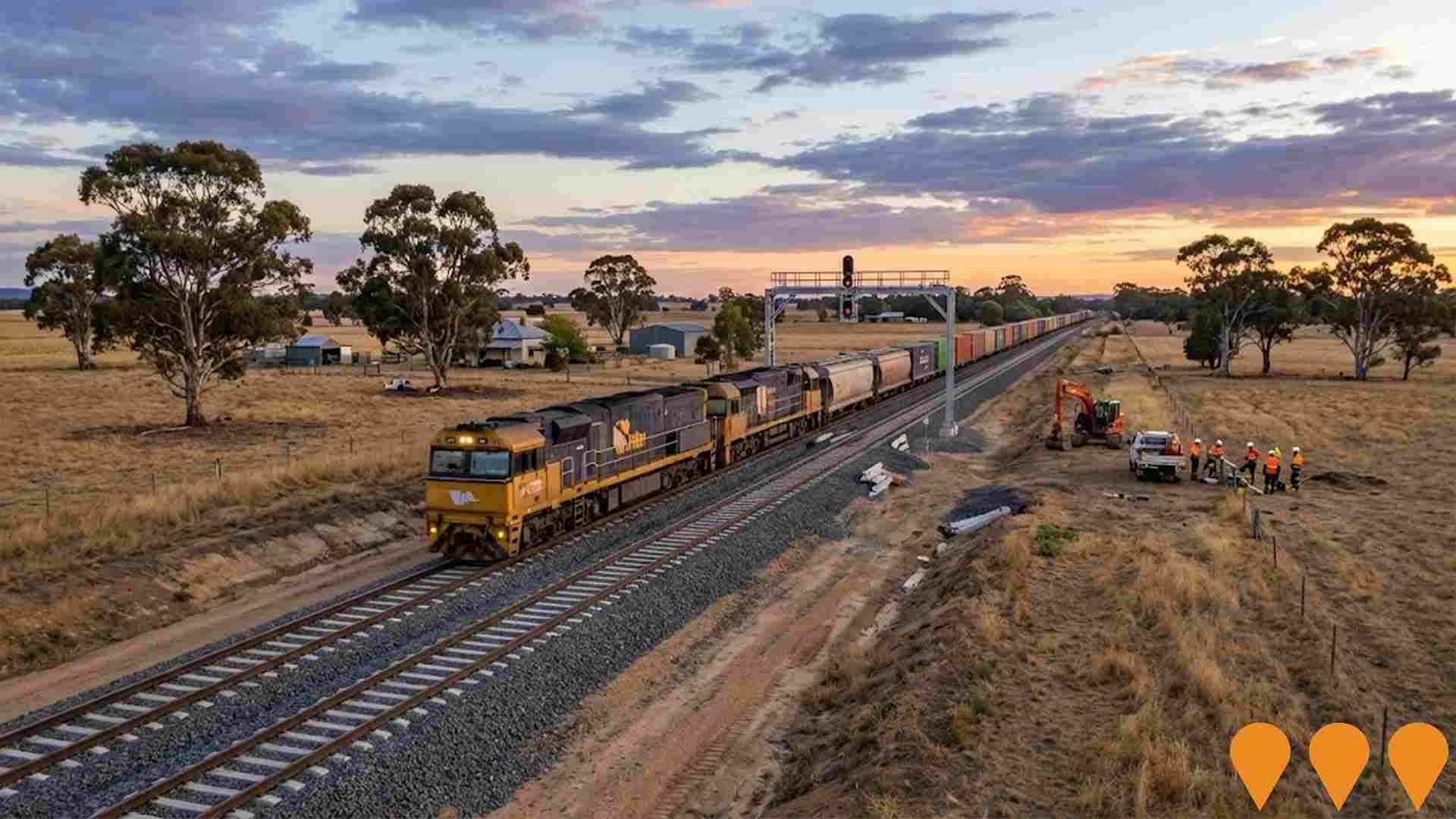Chart Color Schemes
est. as @ -- *
ABS ERP | -- people | --
2021 Census | -- people
Sales Activity
Curious about local property values? Filter the chart to assess the volume and appreciation (including resales) trends and regional comparisons, or scroll to the map below view this information at an individual property level.
Find a Recent Sale
Sales Detail
Population
An assessment of population growth drivers in Maryborough reveals an overall ranking slightly below national averages considering recent, and medium term trends
Maryborough Vic's population is 8,370 as of Aug 2025. This reflects a 210 person increase since the 2021 Census which reported 8,160 people. The change was inferred from ABS estimated resident population of 8,255 in Jun 2024 and additional 86 validated new addresses since the Census date. Population density is 183 persons per square kilometer. Maryborough's growth rate of 2.6% since census compares favourably with non-metro areas' average growth rate of 5.5%. Interstate migration contributed approximately 78.9% to recent population gains.
AreaSearch uses ABS/Geoscience Australia projections for each SA2 area released in 2024, based on 2022 data. For uncovered SA2 areas, VIC State Government's Regional/LGA projections from 2023 are used with adjustments made via weighted aggregation of population growth. Growth rates by age group are applied across all areas for years 2032 to 2041. Future demographic trends suggest lower quartile growth in non-metropolitan areas nationally, with Maryborough expected to grow by 176 persons to 2041, a total gain of 0.4% over the 17 years.
Frequently Asked Questions - Population
Development
Residential development activity is lower than average in Maryborough according to AreaSearch's national comparison of local real estate markets
Maryborough has seen approximately 45 new homes approved annually over the past five financial years, totalling 226 homes. As of FY-26, 8 approvals have been recorded. On average, 0.3 people per year moved to the area for each dwelling built between FY-21 and FY-25, indicating supply meeting or exceeding demand. New properties are constructed at an average value of $409,000.
In this financial year, $13.6 million in commercial development approvals have been recorded. Maryborough maintains similar construction rates per person compared to the rest of Victoria, preserving market balance while recent activity has eased slightly. Recent construction comprises 83.0% detached dwellings and 17.0% attached dwellings, maintaining low density with an emphasis on detached housing.
The area has approximately 255 people per dwelling approval. Future projections show Maryborough adding 35 residents by 2041. Current construction levels should adequately meet demand, creating favourable conditions for buyers while potentially enabling growth that exceeds current forecasts.
Frequently Asked Questions - Development
Infrastructure
Maryborough has moderate levels of nearby infrastructure activity, ranking in the 44thth percentile nationally
Changes to local infrastructure significantly impact an area's performance. AreaSearch identified nine projects likely affecting the region. Notable projects include Maryborough and District Hospital Redevelopment, Central Goldfields Land Use Planning Framework, Maryborough Central Activity District (MCAD), and Maryborough Municipal Olympic Swimming Pool Upgrade. The following list details those most relevant.
Professional plan users can use the search below to filter and access additional projects.
INFRASTRUCTURE SEARCH
 Denotes AI-based impression for illustrative purposes only, not to be taken as definitive under any circumstances. Please follow links and conduct other investigations from the project's source for actual imagery. Developers and project owners wishing us to use original imagery please Contact Us and we will do so.
Denotes AI-based impression for illustrative purposes only, not to be taken as definitive under any circumstances. Please follow links and conduct other investigations from the project's source for actual imagery. Developers and project owners wishing us to use original imagery please Contact Us and we will do so.
Frequently Asked Questions - Infrastructure
Maryborough and District Hospital Redevelopment
A $115 million redevelopment delivering a new urgent care centre, 32-bed inpatient unit, two operating theatres, and maternity unit. The new hospital tower opened in April 2025, with final external works, including the demolition of the old urgent care centre and new forecourt landscaping, scheduled for completion by late 2025.
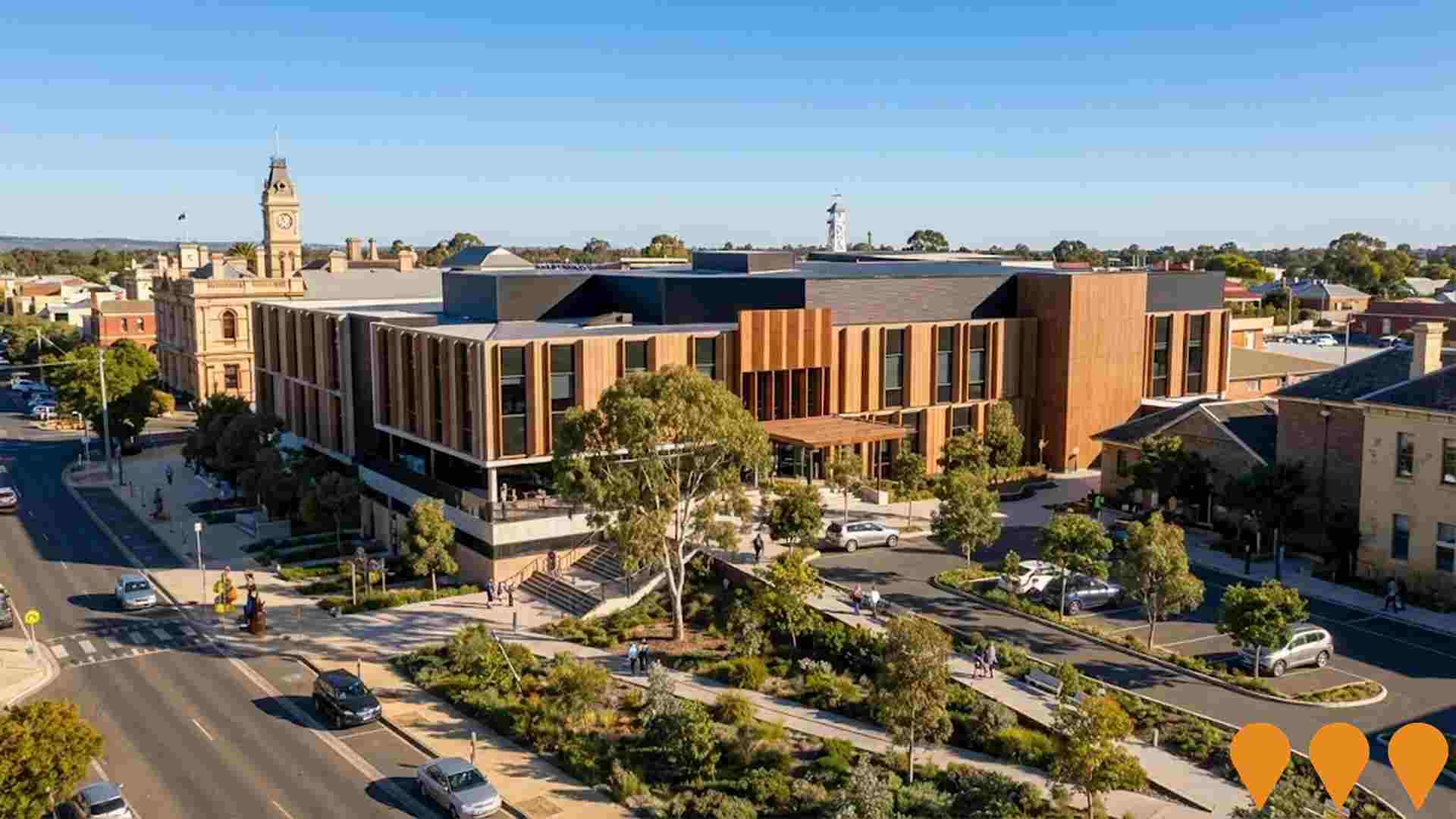
Victorian Renewable Energy Zones
VicGrid, a Victorian Government agency, is coordinating the planning and staged declaration of six proposed onshore Renewable Energy Zones (plus a Gippsland shoreline zone to support offshore wind). The 2025 Victorian Transmission Plan identifies the indicative REZ locations, access limits and the transmission works needed to connect new wind, solar and storage while minimising impacts on communities, Traditional Owners, agriculture and the environment. Each REZ will proceed through a statutory declaration and consultation process before competitive allocation of grid access to projects.
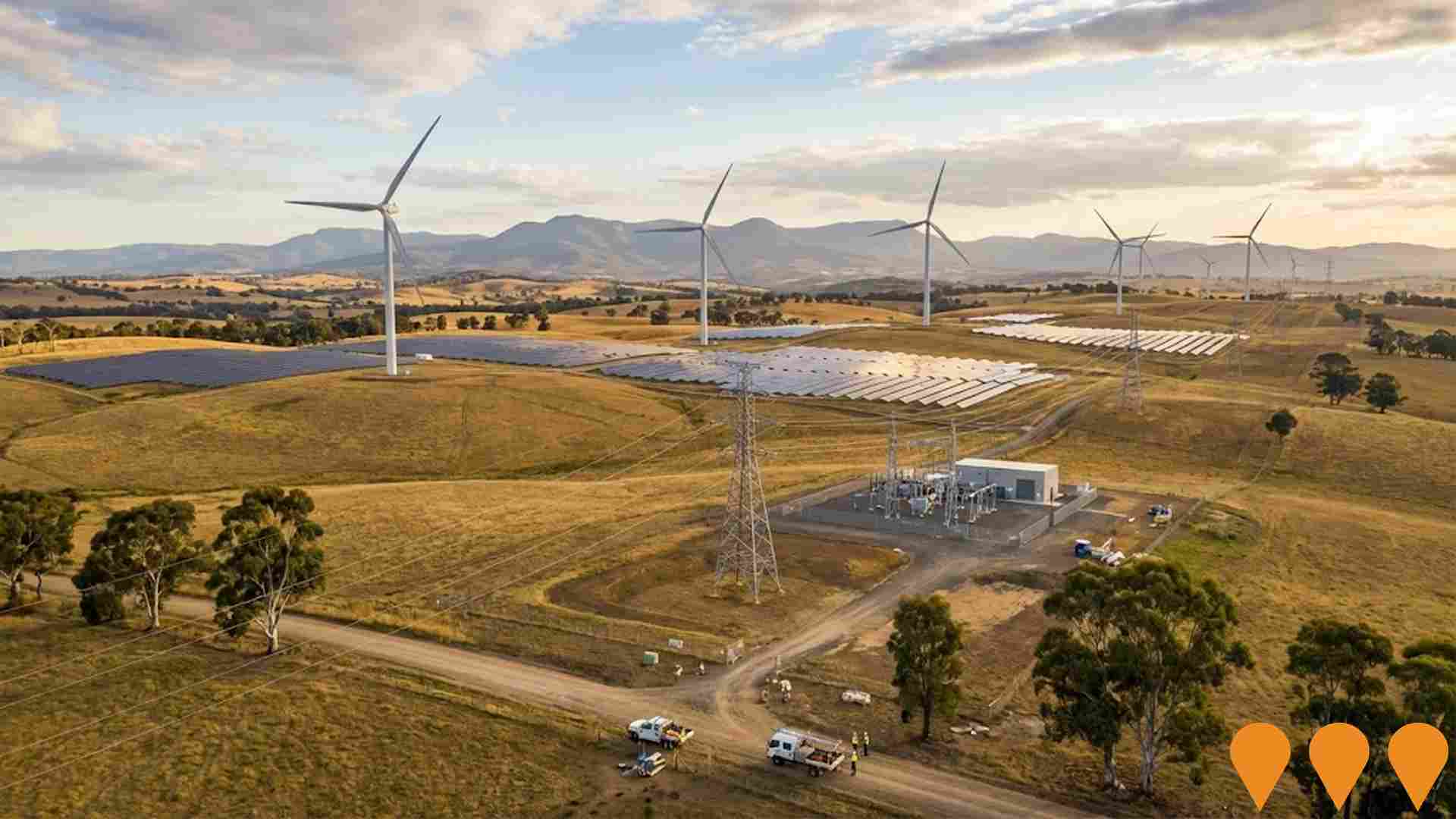
Castlemaine Maryborough Rail Trail
A proposed 55km rail trail linking the goldfields towns of Castlemaine and Maryborough, following the disused Moolort railway line. The project is in the pre-construction phase after completing the feasibility study in 2023, with funding secured for detailed planning and design to achieve shovel-ready status by January 2026. It aims to promote cycling, walking, horse-riding, and tourism through scenic landscapes including volcanic plains, the Loddon River, Cairn Curran Reservoir, and wetlands.
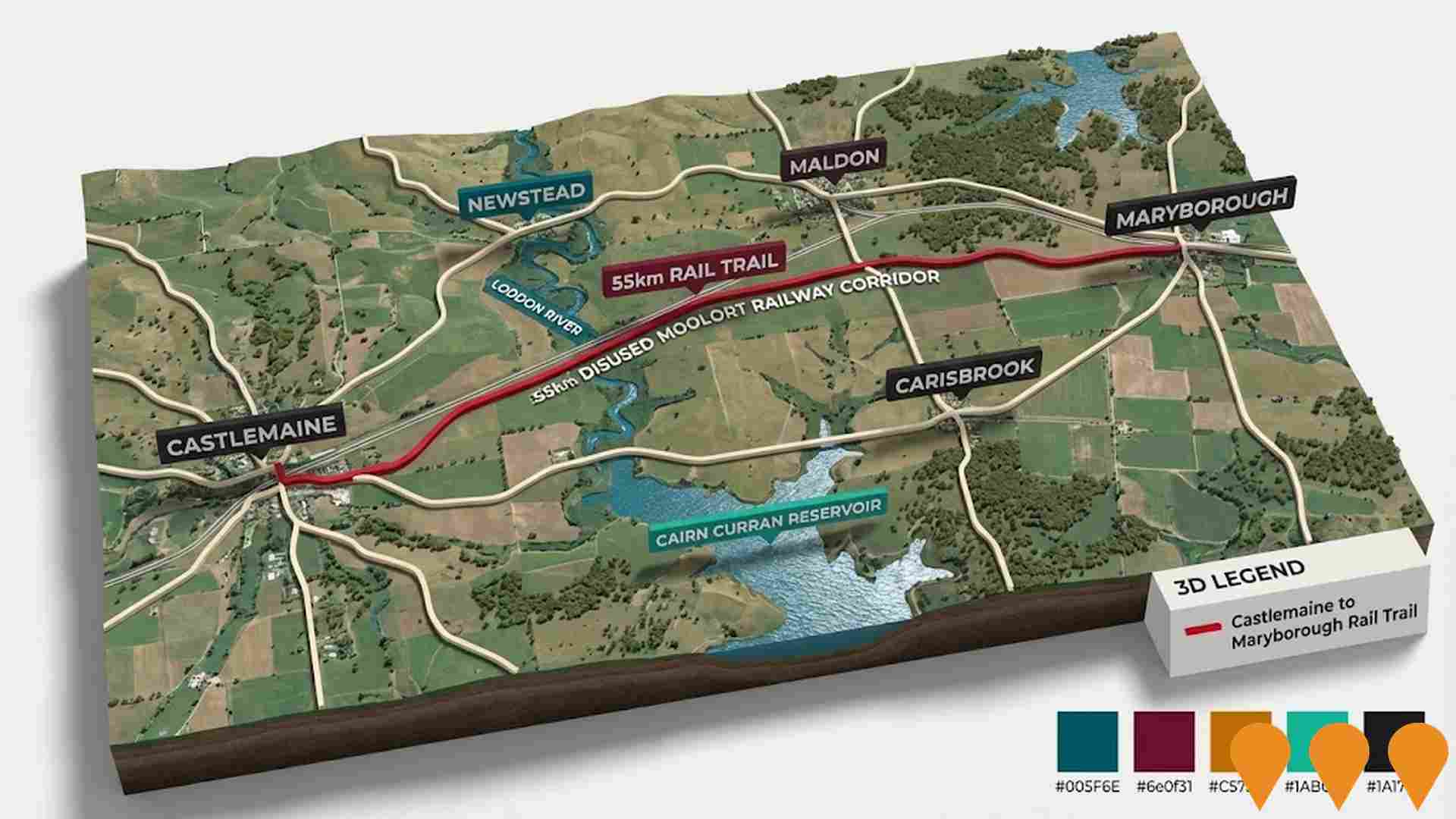
Central Goldfields Land Use Planning Framework
Strategic planning project to identify areas for growth in Central Goldfields Shire to meet future housing and industrial needs. Community consultation has identified preferences for preserving rural lifestyle while supporting controlled development with appropriate infrastructure. Planning includes Maryborough, Carisbrook, and surrounding townships.

Maryborough Central Activity District (MCAD)
The Maryborough Central Activity District (MCAD) involves significant public sector investment to revitalize key civic anchor sites in Central Maryborough. It aims to leverage these projects to drive public realm improvements, support affordable town-centre housing, and stimulate private sector investment in retail, tourism, hospitality, and services sectors. The project includes re-imagining spaces like the Post Office, courthouse, and Town Hall as a civic square or open plaza, integrating urban infrastructure treatments to enhance walkability and connect key areas such as the Central Goldfields Art Gallery, High Street retail area, and the redeveloped Hospital precinct.

Maryborough Municipal Olympic Swimming Pool Upgrade
Renovation and rebuilding of the heritage-listed Maryborough Olympic Outdoor Pool Complex. Stage One includes full renovation of the intermediate/learn to swim pool with new filtration system, balance tank, tiling, shell repairs, disability access ramp; upgrade to pavilion for new compliant entry, kiosk, car parking, footpaths, ramps, landscaping; new standalone change room building with family change rooms and accessibility; plant room repairs; upgrades to existing change rooms; and site services upgrades. Stage Two includes demolition and rebuild of the 50-metre pool, new concourse, filtration system, balance tank, and connecting footpaths.

Industrial Employment Precinct
The Industrial Employment Precinct involves the development of a new industrial precinct on a large 18 hectare Council-owned site zoned Industrial 1. The project includes detailed design work, a development plan, subdivision, site clean-up, and infrastructure provision such as a sewer pump station and local network to unlock over 80 hectares of Industrial Zone land. This will enable the rapid establishment of multiple businesses and a relocated council depot, creating hundreds of construction and ongoing local jobs.
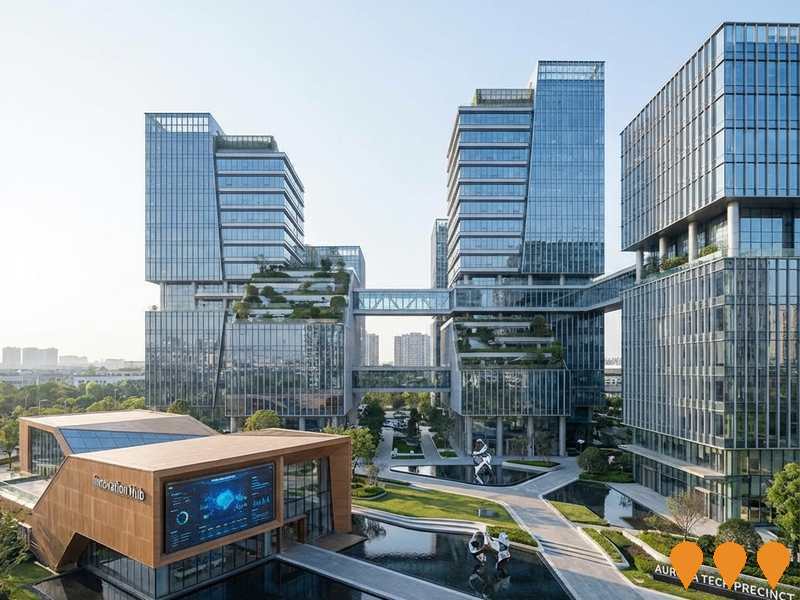
Western Highway Ballarat to Stawell Upgrade
Multi-billion dollar highway duplication project between Ballarat and Stawell, with 55km already completed between Ballarat and Buangor. The project includes adding two lanes in each direction with central median, upgrading intersections, and building new bridges. Benefits freight movement and regional connectivity including to Maryborough area.

Employment
The labour market performance in Maryborough lags significantly behind most other regions nationally
Maryborough Victoria has a balanced workforce with white and blue collar jobs. Key sectors include essential services, with an unemployment rate of 8.5% as of June 2025.
Employment growth over the past year was estimated at 8.7%. There are currently 2,948 residents employed, with an unemployment rate 1 percentage point higher than the rest of Victoria's rate of 3.8%. Workforce participation in Maryborough is lower at 42.6%, compared to the rest of Victoria's 57.4%. Leading employment industries among Maryborough residents are health care & social assistance, manufacturing, and retail trade.
Manufacturing stands out with employment levels at 1.9 times the regional average. However, agriculture, forestry & fishing is under-represented, with only 3.7% of Maryborough's workforce compared to 7.5% in the rest of Victoria. Many residents commute elsewhere for work, as indicated by the Census working population count. In the past year, employment increased by 8.7%, while the labour force grew by 6.8%, leading to a 1.6 percentage point decrease in unemployment rate. Conversely, the rest of Victoria experienced employment and labour force declines of 0.9% and 0.4%, respectively, with a slight rise in unemployment. Jobs and Skills Australia's national employment forecasts from May 2025 suggest potential future demand within Maryborough. National employment is projected to expand by 6.6% over five years and 13.7% over ten years. Applying these projections to Maryborough's employment mix indicates local growth of approximately 5.9% over five years and 13.0% over ten years, though this is a simplified extrapolation for illustrative purposes only.
Frequently Asked Questions - Employment
Income
Income metrics place the area in the bottom 10% of locations nationally according to AreaSearch analysis
AreaSearch's aggregation of the latest postcode level ATO data released for financial year 2022 shows Maryborough had a median income among taxpayers of $42,118. The average income stood at $49,812, which is below the national average. In comparison, Rest of Vic had levels of $48,741 and $60,693 respectively. Based on Wage Price Index growth of 12.16% since financial year 2022, current estimates for Maryborough would be approximately $47,240 (median) and $55,869 (average) as of September 2025. Census 2021 income data shows household, family and personal incomes in Maryborough all fall between the 1st and 4th percentiles nationally. Distribution data indicates that 36.1% of the population (3,021 individuals) fall within the $400 - 799 income range, contrasting with the broader area where the $1,500 - 2,999 bracket leads at 30.3%. Economic circumstances reflect widespread financial pressure, with 46.1% of households operating within modest weekly budgets below $800. After housing costs, 85.4% of income remains, ranking at only the 4th percentile nationally.
Frequently Asked Questions - Income
Housing
Maryborough is characterized by a predominantly suburban housing profile, with a higher proportion of rental properties than the broader region
In Maryborough, as recorded in the latest Census, 87.4% of dwellings were houses with the remaining 12.6% being semi-detached, apartments, or other types. This compares to Non-Metro Vic.'s figures of 93.8% houses and 6.2% other dwellings. Home ownership in Maryborough stood at 45.7%, with mortgaged dwellings at 25.6% and rented ones at 28.8%. The median monthly mortgage repayment was $1,000, lower than Non-Metro Vic.'s average of $1,127. Median weekly rent in Maryborough was $240, compared to Non-Metro Vic.'s $230. Nationally, Maryborough's mortgage repayments were significantly lower at $1,000 versus Australia's average of $1,863, and rents were substantially below the national figure of $375.
Frequently Asked Questions - Housing
Household Composition
Maryborough features high concentrations of lone person households, with a lower-than-average median household size
Family households account for 58.2% of all households, including 16.3% couples with children, 28.2% couples without children, and 12.6% single parent families. Non-family households constitute the remaining 41.8%, with lone person households at 39.0% and group households comprising 2.9%. The median household size is 2.1 people, which is smaller than the Rest of Vic. average of 2.2.
Frequently Asked Questions - Households
Local Schools & Education
Maryborough faces educational challenges, with performance metrics placing it in the bottom quartile of areas assessed nationally
The area has lower university qualification rates at 11.7%, significantly below the Victorian average of 33.4%. This presents both a challenge and an opportunity for targeted educational initiatives. Bachelor degrees are most common at 8.6%, followed by graduate diplomas (1.8%) and postgraduate qualifications (1.3%). Vocational credentials are prominent, with 37.5% of residents aged 15+ holding them - advanced diplomas (8.0%) and certificates (29.5%).
A substantial 23.8% of the population is actively pursuing formal education, including 9.2% in primary, 8.0% in secondary, and 1.9% in tertiary education. Maryborough's four schools have a combined enrollment of 1,638 students, with typical Australian school conditions (ICSEA: 985) offering balanced educational opportunities. The educational mix includes one primary, one secondary, and two K-12 schools. The area serves as an education hub with 19.6 school places per 100 residents, significantly above the regional average of 10.7, attracting students from surrounding communities. Note: where schools show 'n/a' for enrolments, please refer to the parent campus.
Frequently Asked Questions - Education
Schools Detail
Nearby Services & Amenities
Transport
Transport servicing is low compared to other areas nationally based on assessment of service frequency, route connectivity and accessibility
Maryborough has 85 active public transport stops offering a mix of train and bus services. These stops are served by 16 routes, providing a total of 578 weekly passenger trips. Residents have excellent transport accessibility, with an average distance of 196 meters to the nearest stop.
Service frequency averages 82 trips per day across all routes, equating to approximately 6 weekly trips per stop.
Frequently Asked Questions - Transport
Transport Stops Detail
Health
Health performance in Maryborough is a key challenge with a range of health conditions having marked impacts on both younger and older age cohorts
Maryborough faces significant health challenges, with various conditions affecting both younger and older residents. Private health cover is low, at approximately 46% (around 3,858 people), compared to the national average of 55.3%.
The most prevalent medical conditions are arthritis (13.2%) and mental health issues (11.7%), while 53.0% report no medical ailments, compared to 56.8% in the rest of Victoria. Maryborough has a higher proportion of seniors aged 65 and over, at 31.3% (2,619 people), than the rest of Victoria at 27.9%. Health outcomes among seniors present challenges but perform better than the general population in health metrics.
Frequently Asked Questions - Health
Cultural Diversity
Maryborough is considerably less culturally diverse than average when assessed alongside AreaSearch's national rankings for language and cultural background related metrics
Maryborough, when assessed for cultural diversity, showed a majority population with 91.6% being citizens, 90.6% born in Australia, and 96.5% speaking English only at home. Christianity was the predominant religion, comprising 50.0% of Maryborough's population, compared to 47.6% across Rest of Vic.. The top three ancestry groups were English (35.1%), Australian (33.2%), and Scottish (8.8%).
Notable differences in ethnic group representation included Maltese at 0.4% (vs regional 0.6%), Irish at 8.2% (vs 9.2%), and Australian Aboriginal at 1.8% (vs 1.4%).
Frequently Asked Questions - Diversity
Age
Maryborough ranks among the oldest 10% of areas nationwide
Maryborough has a median age of 50, which is higher than the Rest of Vic.'s figure of 43 and also above the national average of 38. The 75-84 age group comprises 11.6% of Maryborough's population, compared to Rest of Vic.'s figure, while the 35-44 cohort makes up 9.2%. This 75-84 concentration is higher than the national average of 6.0%. According to the 2021 Census, the 15 to 24 age group has increased from 9.5% to 11.2%, and the 35 to 44 cohort has grown from 8.1% to 9.2%. Conversely, the 65 to 74 cohort has decreased from 15.9% to 14.4%. Demographic modeling indicates that Maryborough's age profile will significantly change by 2041. The 25 to 34 age group is projected to grow strongly, adding 327 people (a 38% increase) from 872 to 1,200. Conversely, population declines are projected for the 75 to 84 and 65 to 74 cohorts.
